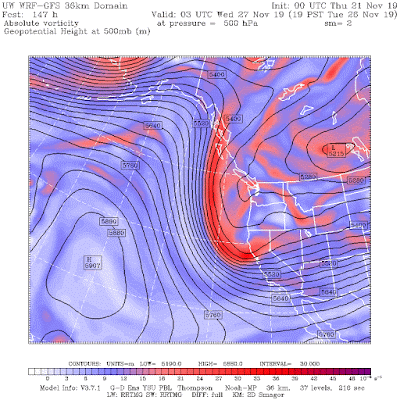The media is often full of negative and depressing news, and this week the Seattle Times did not disappoint, with an article suggesting that
Seattle is the gloomiest city in the U.S. And their cartoonist, David Horsey, followed up with more of the same.
But inquisitive Seattle residents might ask:
is this really true? Is Seattle truly in the basement of gloom?
Perhaps not...so let's explore this issue, from both psychological and meteorological viewpoints. Now, first--what is gloom? As shown by the definition below, it can either refer to darkness, or more importantly, a state of melancholy or low spirits.
There is, in fact, a scientific literature on the distribution of gloom around the nation. What does it say?
One example (
here), providing a map of mental distress across the nation, suggests that Seattle is far from the worst, with parts of California and the torrid southeast U.S. being far sadder. The paper talks describes the "gloom belt", and folks, we are not in it.
But being in high-tech Seattle, let's check the results of mining the twitter archive to judge regional mood (
another peer-reviewed article), with higher numbers indicating more happy tweets. Washington is one of the happier states! (Yes, Hawaii is the most happy, with Maine and Nevada right behind).
So clearly, there was something wrong with the gloom index used by the Seattle Times, which is only based on percent of cloud cover, hours of daylight, and days with precipitation (and put together by a website called
Best Places).
Now there is a lot the gloomers at Best Places/Seattle Times missed. For example, did you know that too MUCH sun is depressing?
It is called Summer Affective Disorder (SAD) or Summer Depressive Disorder. Oppressive, ever-present sun. High humidity. Glare. Sweat. Biting insects. In many places (SW U.S., India, SE U.S.), summer depression is a real problem.
Looking the summer heat index, which combines temperature and humidity, the SE and SW U.S. are just miserable during the summer. And it is well known that crime and disorder increase during very warm weather.
But we generally escape this affliction in the Northwest, with the most pleasant summers in the nation, particularly west of the Cascade crest. So it makes sense that from late spring through early fall, Seattle residents are happier than many others around the nation.
The gloom analysts at Best Places and the Seattle Times also miss out
that many people like rain. In fact, there is a
literature describing how rain can make people happier. One theory is that rain is a source of white noise that is pleasant for the brain. That is certainly true for me. It is also an excuse to find a warm, cozy spot, to reflect, enjoy tea or coffee, or to read. You don't feel guilty for not running around outside. Life is good.
Other studies suggest after living in a place in constant sunshine, the brain adapts and takes no notice. In contrast, here in the Northwest, when winter clouds part to give us a good shot of sun, our brains are flooded with neurotransmitters, providing a psychological high.
To give a pharmacological analogy. If one takes pain killers for an extended period in time, they lose their effects. In contrast, if you take one rarely, they give you quite a jolt when you take one. The difference between living in San Diego or Seattle.
But there is more. During Seattle winter, many of the trees and ferns are still green and vibrant, and our grass stays green, in stark contrast, to the brown, lifeless (depressing) vegetation over much of the U.S. (the picture below was taken on January 7th by Peter Stevens).

And on many a winter day, it is easily possible to get some sun with a short drive, into the mountains, past the Cascade crest, or to sunny Sequim. Many Seattle residents know this.
I hope the Seattle Chamber of Commerce has a little "talk" with the gloommeisters at the Seattle Times. Perhaps Jeff Bezos knew what he was doing when he build Amazon here in Seattle, as did so many other leading firms. And yes, there is a movie I can recommend:
_____________________________
Announcement: I will be teaching Atmospheric Sciences 101 during winter quarter
If anyone is interested, either a UW student or outside folks using the ACCESS program, I will be teaching this general introduction to weather in Kane Hall (210) at 12:30 PM.






























































